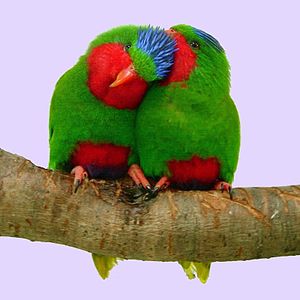Blue cap
| Blue cap | ||||||||||||
|---|---|---|---|---|---|---|---|---|---|---|---|---|

Blue skullcap ( Vini australis ) |
||||||||||||
| Systematics | ||||||||||||
|
||||||||||||
| Scientific name | ||||||||||||
| Vini australis | ||||||||||||
| ( Gmelin , 1788) |
The blue- hooded lory ( Vini australis ), more rarely also called blue- hooded lory or blue-capped lory , is a species of parrot from the genus of the maid loris ( Vini ). The blue cap is u. a. distributed in American Samoa , Fiji , Niue , Samoa , Tonga , Wallis, and Futuna .
description
The delicate blue skullcap reaches a body length of 19 cm. Its bright blue crown and red throat and belly are striking. Nevertheless, the color green dominates, which is noticeable from the tip of the tail to the head. The green is lighter around the neck and rump . The upper tail is green at the base, the tips of the central feathers are yellow. The under tail is yellowish green. The blue skullcap has a small, orange, strongly curved bill and pink-red colored thighs and feet. The iris is yellow.
The plumage of the young birds is largely the same as that of the adult birds, but with less red on the neck and face, little or no red color on the belly. In addition, the young birds have short blue stripes on the crown and their thighs and feet are not yet colored pink like the adult birds. In addition, her iris is brown.
habitat
Blue skulls can be found in forests with coconut palms ( Cocos nucifera ). But they also like to stay in coastal mountains, gardens and agricultural areas and plantations. Sometimes some troops travel from island to island.
Way of life
Blue skulls are quite gregarious and defend their territories very aggressively against intruders. They usually band together in groups of up to a dozen individuals to prey on nectar, pollen, fruits, insect larvae and arachnids. Blue skulls are loyal to their partner for a lifetime.
Blue skulls hatch an egg or two between June and August. The nest is made in a tree hole.
status
As the only representative of the genus Maidloris, the blue skull is not considered endangered - not least because of its rather wide distribution area. Nevertheless, the population is shrinking on most of the islands, especially on Tonga, due to the unintentional importation of the house rat ( Rattus rattus ).
literature
- Thomas Arndt: Lexicon of Parrots. Arndt Verlag, 2001
- Joseph M. Forshaw: Parrots of the World: An Identification Guide. Princeton University Press, Princeton, New Jersey, and Woodstock, United Kingdom 2006. ISBN 978-0-691-09251-5
Individual evidence
- ^ A b c Mike Parr, Tony Juniper: Parrots: A Guide to Parrots of the World. Bloomsbury Publishing, 2003, ISBN 978-0713669336 , pp. 241-242.
Web links
- Vini australis inthe IUCN Red List of Threatened Species 2014.3. Listed by: BirdLife International, 2012. Retrieved April 15, 2015.
- Videos, photos and sound recordings for Blue-crowned Lorikeet (Vini australis) in the Internet Bird Collection
- Zoo animal list: blue cap (blue cap lory) Vini australis
- http://www.markuskappeler.ch/tex/texs/blaukappenlori.html